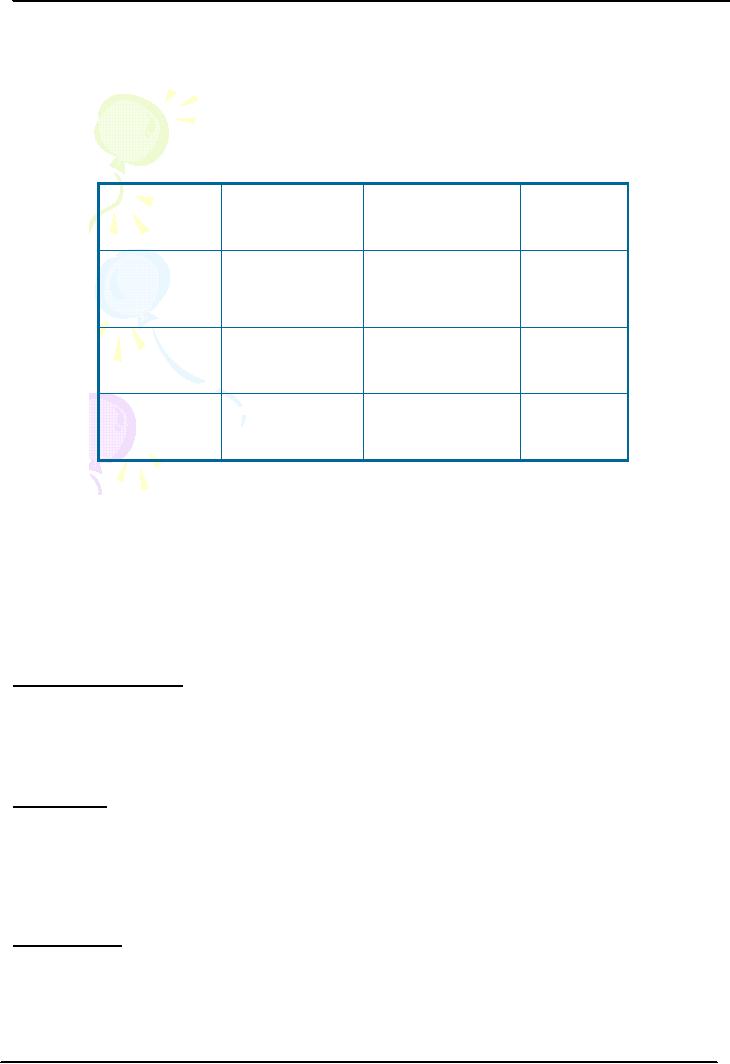 |

Theory
and Practice of Counseling -
PSY632
VU
Lesson
19
COUNSELING
PROCESS
Link
to the Previous
Lecture
Table
1: Microskill Usage according to
Theoretical
Orientation
Microskill
Client-center
Psychodynamic
Cognitive
Expression
Expression
Questions
Expression
Attending
&
Reflecting
feeling
Behavioral/
Listening
cognitive
deficits
individual
client
individual
client
Individual
and
Focus
We
Past
environment
Feedback
Interpretation
Directive
Influencing&
Reflection
of
Advice
Challenging
meaning
Feedback
One
of the main tasks of counseling is to
assist clients to work
through, resolve, or learn to
live with
incongruities.
Most counseling theories
have as their main focus the
resolution of incongruities.
Reframes
from
other theoretical approaches can
also be helpful. Psychodynamic
theory may be useful and
can help
clients
see how their histories and
past experiences relate to
their present stories.
Cognitive-behavioral
reframes
will often help clients
think more effectively about
their stories and provide
action narratives for
the
future. The existential-humanistic
reframe may help clients
focus on their self-value.
The point of
reframing
is to tell the story in a new way,
one that is more functional
and valuable to the client. The
use of
various
skills by different approaches is as
under:
Attending
and Listening
skills:
Client-centered
approach makes a minimum use
of questions while the major emphasis is
on reflecting
feelings.
The therapist attempts to minimize influence on
client's constructions and
meanings. In
psychodynamic
approach questions and
encouragers are especially
important to facilitate exploration
or
unconscious
processes. The cognitive
approach focuses on noting
cognitive distortions.
Focusing
skills:
Client-centered
approach focuses primarily
on
the individual client. The
problem will often be
conceptualized as
one
of
understanding
one's
own
unique
needs
and
wishes. The major goal is
self-actualization of the client. The
psychodynamic focus is also
on
individual
client.
The
problem is to understand how
past experience affects what
occurs in the present. A major goal
is
to
understand unconscious mental
processes.
Influencing
skills:
All
influencing skills are
oriented in different ways
toward the same objective: finding
new ways to think
about,
and then act on,
old narratives and stories.
Rogerian person-centered counseling
employs very few
of
these influencing skills.
Cognitive-behavioral theory, however,
uses an extensive array of
influencing
change
strategies. You as a professional
counselor or therapist will want to find
the balance and blend
listening
and influencing that you
believe to be most appropriate
81

Theory
and Practice of Counseling -
PSY632
VU
Counseling
Process
Factors
Influencing the Counseling
Process
In
counseling process we will
discuss factors affecting the counseling
process. In addition to that, we
will
study
about the first interview, middle
phase (working in a counseling
relationship) and finally the
last
interviews
or termination of counseling
process.
The
counseling process is influenced by
several characteristics that
help it become a productive time
for the
client
and counselor. Not all
characteristics apply to all situations,
but generally, the following
help bring
about
positive results.
The
process of counseling develops in
definable stages with recognizable
transitions. The first
stage
involves
building a relationship. It focuses on
engaging clients to explore issues
that directly affect them.
Two
struggles take place at that
time:
1.
Battle
for structure, which involves
issues of administrative control, by
counselor (scheduling, fees,
and
participation
in sessions)
2.
Battle
for initiative which
concerns motivation for
change and client responsibility. It is
important that
the
counselor wins the first battle
and the client wins the
second.
Let's
discuss all of the important
factors influencing counseling
process:
�
Structure
�
Initiative
�
Setting
�
Client
Qualities
�
Counselor
Qualities
1.
Structure
�
It
refers to the "joint understanding
between the counselor & client
regarding the characteristics,
conditions,
procedures, and parameters of counseling"
(Day & Sparacio, 1980,
p.246).
o
Structure
helps clarify the counselor-client relationship. This
give form to what the
formal
process
will look like. Many
clients come to counseling
with no idea what to
expect.
Counseling
moves forward when client
and counselor know the
boundaries of the relationship
and
what is expected.
o
Structure
protects the rights, roles, and
obligations of both client and
counselor.
o
Practical
guidelines are part of
building structure. They include time limits, action
limits,
procedural
limits, specific goals and
needs, fee, audio- or video-recording,
permission to record,
etc.
this is therapeutic in itself.
o
Structure
is more important when a
client has unrealistic
expectation.
o
Structure
is especially important in the beginning
but is provided throughout
all stages.
o
To
help client new directions to
their life, constructive guidelines
are provided as clients are
in
a
static state.
o
The
counselor needs to stay
flexible and continually
negotiate the nature of the structure
with
their
clients.
A
sample client-counselor contract,
provided by Witmer & Remley from
University of Florida, is given
below
to enhance students'
understanding:
82

Theory
and Practice of Counseling -
PSY632
VU
Example:
Counselor-Client Contract: (Witmer &
Remley, 1994)
Introduction:
Our profession is becoming more attuned
to client rights as well as to
counselor
accountability.
Both give their addresses
here. Please feel free to
change the contract......
�
Qualification/
Experience
�
Nature
of counseling (the emphasis is on the
professional relationship)
�
Referrals
�
Fee
cancellation & insurance
�
Records
& confidentiality
�
Signatures
2.
Initiative, Reluctance &
Resistance
Initiative
can be
thought of as the motivation that the
client brings into the
session.
Majority
of the client are reluctant to some
degrees. However, Reluctance
is
generally seen in those
clients
who
are referred for help by a
third party and are
unmotivated, e.g., school children,
and court-referred
clients.
In such a situation, some counselors
become impatient, irritated and
insensitive, and may
ultimately
give
up. Counselor needs to understand the
dynamics involved in working
with difficult
clients.
Resistance
is unwillingness to
change. Resistant clients
bring a motivation to cling to their
issues through
various
sorts of actions like those
with "I don't know"
statement. Resistant clients want to
cling to the
certainty
of present and do not want to
face the pain that change
demands.
Four
broad categories of resistant
clients (Otani,
1988):
Otani
has pointed out 22 forms of
resistance which can be
categorized into 4, as described
below:
�
Amount
of verbalization: shown by silence and
minimum talk.
�
Content
of message: intellectual talk, emotional
display, future/past preoccupation,
symptom
preoccupation,
etc.
�
Style
of communication: false promising, thought
editing, last-minute disclosure,
externalization,
thought
editing, false promising,
etc.
�
Attitude
toward counselor and
counseling session: poor
appointment keeping, payment
delays, favor
asking,
etc.
Ways
to let client win the
battle for
initiative:
�
To
anticipate the anger and
defensiveness
�
To
show acceptance and
understanding
�
To
use persuasion
�
Through
confrontation; client can
respond by:
o
Denial
o
Accepting
confrontation as true
o
Developing
a middle position.
�
Using
pragmatic techniques: Roloff
and Miller have mentioned
two pragmatic persuasion
techniques:
door
in the face, and foot in the
door. Other pragmatic
techniques could be silence,
reflection,
questioning,
sharing, etc.
3.
Physical Setting
�
Counseling
can happen anywhere, but a
professional counselor generally
prefers to work in a place
that
provides
privacy, confidentiality, and
quietness.
83

Theory
and Practice of Counseling -
PSY632
VU
�
There
is no universal quality that a
room should have "except it should
not be overwhelming, noisy, or
distracting"
(Benjamin, 1987, p. 3). Room should facilitate rather
than distracting the client. In this
reference,
Shertzer & Stone (1980) indicated
that the room should be comfortable and
attractive.
�
Features
of a counseling room:
o
Soft
lighting
o
Quiet
colors
o
An
absence of clutter
o
Harmonious
and comfortable furniture
o
The
spatial features of the
environment;
Optimum
distance: A distance of 30-39
inch between counselor and
client has been
found
to be the average range of
comfort.
Desk:
Pietrofesa et al. (1984)
note the symbolic and
physical barrier of a large
desk.
Auditory
and visual privacy is mandatory for
maximum client-disclosure.
4.
Physical Arrangement
�
Different
layouts of the therapy
office
Cultural
and gender preferences may
exist, but individual
differences are the most
important variation to
observe.
Positioning is expressed by the clinician in the
layout of the therapy office.
o
a
large desk is positioned
between client and clinician
o
a
small desk is positioned
between client and
clinician
o
the
clients and clinicians
chairs are directly across
from each other without
obstacles in
between
�
Arrangement
of chairs should be arranged in
relation to each other
o
face-to-face
arrangements
o
side-by-side
seating
A
therapy office that is set up so
that a desk is positioned
between client and clinician
will communicate
something
very different from a therapy room in
which the clients and
clinicians chairs are
directly across
from
each other without obstacles
in between. Similarly, the decision about
how a client's and
counselor's
chairs
should be arranged in relation to each
other communicates different things to
different clients.
For
some,
face-to-face arrangements may
suggest an attempt at emotional sharing;
for others, only
side-by-side
seating
may be acceptable. Benjamin (1987)
suggests two chairs and a
nearby table. Observation about
how
clients
react to the layout may be
helpful in making necessary
revisions
5.
Client Qualities
�
Clients
come in all shapes and
sizes, personality characteristics, and
degrees of attractiveness
(Warnath,
1977).
Counselors' interaction is influenced by the
physical characteristics of the client
(Goldstein,
1973)
�
The
most successful clients tend
to be YAVIS (Young, attractive, verbal, intelligent,
successful)
compared
to HOUNDs (homely, old, unintelligent,
nonverbal, and disadvantaged), or DUDs
(dumb,
unintelligent
and disadvantaged).
�
These
observations show that
ironically disability and
age provide invisible but
powerful barriers.
�
Total
liking is determined by verbal, vocal,
and facial liking. However,
in a study nonverbal
behavior
was
shown to be more important
(Facial expressions = 55%) than either
vocal (38%) or verbal (7%)
cues
(Mehrabian et al.,
1971).
�
Counselors
generally like to work with
clients who are most
like them. It is important to be
aware of
cultural
differences in nonverbal messages
(Sielska, 1979)
84
Table of Contents:
- INTRODUCTION:Counseling Journals, Definitions of Counseling
- HISTORICAL BACKGROUND COUNSELING & PSYCHOTHERAPY
- HISTORICAL BACKGROUND 1900-1909:Frank Parson, Psychopathic Hospitals
- HISTORICAL BACKGROUND:Recent Trends in Counseling
- GOALS & ACTIVITIES GOALS OF COUNSELING:Facilitating Behavior Change
- ETHICAL & LEGAL ISSUES IN COUNSELING:Development of Codes
- ETHICAL & LEGAL ISSUES IN COUNSELING:Keeping Relationships Professional
- EFFECTIVE COUNSELOR:Personal Characteristics Model
- EFFECTIVE COUNSELOR:Humanism, People Orientation, Intellectual Curiosity
- EFFECTIVE COUNSELOR:Cultural Bias in Theory and Practice, Stress and Burnout
- COUNSELING SKILLS:Microskills, Body Language & Movement, Paralinguistics
- COUNSELING SKILLS COUNSELOR’S NONVERBAL COMMUNICATION:Use of Space
- COUNSELING SKILLS HINTS TO MAINTAIN CONGRUENCE:
- LISTENING & UNDERSTANDING SKILLS:Barriers to an Accepting Attitude
- LISTENING & UNDERSTANDING SKILLS:Suggestive Questions,
- LISTENING & UNDERSTANDING SKILLS:Tips for Paraphrasing, Summarizing Skills
- INFLUENCING SKILLS:Basic Listening Sequence (BLS), Interpretation/ Reframing
- FOCUSING & CHALLENGING SKILLS:Focused and Selective Attention, Family focus
- COUNSELING PROCESS:Link to the Previous Lecture
- COUNSELING PROCESS:The Initial Session, Counselor-initiated, Advice Giving
- COUNSELING PROCESS:Transference & Counter-transference
- THEORY IN THE PRACTICE OF COUNSELING:Timing of Termination
- PSYCHOANALYTIC APPROACHES TO COUNSELING:View of Human Nature
- CLASSICAL PSYCHOANALYTIC APPROACH:Psychic Determination, Anxiety
- NEO-FREUDIANS:Strengths, Weaknesses, NEO-FREUDIANS, Family Constellation
- NEO-FREUDIANS:Task setting, Composition of Personality, The Shadow
- NEO-FREUDIANS:Ten Neurotic Needs, Modes of Experiencing
- CLIENT-CENTERED APPROACH:Background of his approach, Techniques
- GESTALT THERAPY:Fritz Perls, Causes of Human Difficulties
- GESTALT THERAPY:Role of the Counselor, Assessment
- EXISTENTIAL THERAPY:Rollo May, Role of Counselor, Logotherapy
- COGNITIVE APPROACHES TO COUNSELING:Stress-Inoculation Therapy
- COGNITIVE APPROACHES TO COUNSELING:Role of the Counselor
- TRANSACTIONAL ANALYSIS:Eric Berne, The child ego state, Transactional Analysis
- BEHAVIORAL APPROACHES:Respondent Learning, Social Learning Theory
- BEHAVIORAL APPROACHES:Use of reinforcers, Maintenance, Extinction
- REALITY THERAPY:Role of the Counselor, Strengths, Limitations
- GROUPS IN COUNSELING:Major benefits, Traditional & Historical Groups
- GROUPS IN COUNSELING:Humanistic Groups, Gestalt Groups
- MARRIAGE & FAMILY COUNSELING:Systems Theory, Postwar changes
- MARRIAGE & FAMILY COUNSELING:Concepts Related to Circular Causality
- CAREER COUNSELING:Situational Approaches, Decision Theory
- COMMUNITY COUNSELING & CONSULTING:Community Counseling
- DIAGNOSIS & ASSESSMENT:Assessment Techniques, Observation
- FINAL OVERVIEW:Ethical issues, Influencing skills, Counseling Approaches